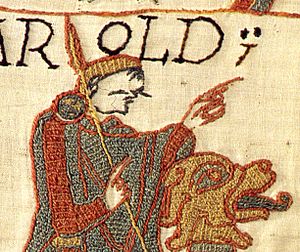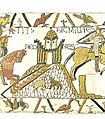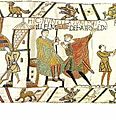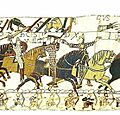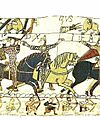Bayeux Tapestry tituli facts for kids
The Bayeux Tapestry captions are special Medieval Latin words and sentences sewn onto the famous Bayeux Tapestry. These captions, called tituli (say "TIT-you-lee"), help explain the pictures on the tapestry. They tell the story of important events leading up to the Norman conquest of England. This includes the story of William, Duke of Normandy, and Harold, Earl of Wessex, who later became King of England. The story ends with the big Battle of Hastings.
What are the Bayeux Tapestry Captions?
The Bayeux Tapestry was likely ordered by Bishop Odo, who was William the Conqueror's half-brother. It was probably made around the 1070s, possibly at the same time the Bayeux Cathedral was being built. It was finished by 1077, just in time for the cathedral's opening!
The tapestry is made from wool yarn sewn onto linen cloth. Most of the words are sewn with dark blue wool, almost black. But towards the end of the tapestry, different colors are used for words or even individual letters.
The tapestry mostly shows pictures, but the tituli (captions) are very important. They point out the names of people and places. They also briefly explain what is happening in each scene. The text is in Latin, which was the common language for important documents back then. It's usually very clear and simple, directly describing the pictures.
Sometimes, words are shortened with a special mark called a tilde (a wavy line) over them. This means some letters are missing. The words are often separated by two dots, like colons. More important breaks in the story are sometimes marked with three dots. Many names of people, especially English ones, are not changed into Latin. The same goes for place names in England and some in France.
Key Moments from the Captions
The captions tell the story scene by scene. Here are some of the most important parts:
- Harold's Journey: The tapestry begins by showing King Edward. Then, it shows Harold, an English leader, riding to church and sailing across the sea.
- Harold and William: Harold lands in the area of Count Wido. Wido captures Harold and takes him to Beaurain. Messengers from Duke William then arrive. William eventually leads Harold to his palace.
- The Oath: A very important scene shows William giving weapons to Harold. Then, Harold makes a serious promise, or "oath," to Duke William in Bayeux.
- King Edward's Death: Harold returns to England and goes to King Edward. The tapestry shows King Edward on his deathbed, speaking to his loyal followers, and then he dies.
- Harold Becomes King: After King Edward's death, Harold is given the king's crown. He is shown sitting as the new King of the English, with Archbishop Stigand nearby.
- The Star: People are shown looking up at a mysterious star. This might be Halley's Comet, which appeared in 1066 and was seen as a sign of change.
- William Prepares: An English ship arrives in Duke William's land. William then orders many ships to be built. The tapestry shows men dragging ships to the sea and carrying weapons and supplies onto them.
- The Invasion: Duke William crosses the sea in a large ship and lands at Pevensey. His horses leave the ships, and his knights quickly go to Hastings to find food.
- Before the Battle: William is told about Harold's army. A house is shown burning. William's knights leave Hastings to fight King Harold. William asks one of his men, Vital, if he has seen Harold's army. Another messenger tells King Harold about Duke William's army.
- The Battle of Hastings: Duke William speaks to his knights, telling them to prepare bravely for the battle against the English army. During the fight, Harold's brothers, Leofwine and Gyrth, are killed. Both English and French soldiers fall in battle. Bishop Odo is shown encouraging the soldiers.
- Harold's Death: The tapestry shows the moment King Harold is killed.
- The English Retreat: The final caption says that the English soldiers have turned and run away.
The end of the tapestry is missing, so we don't know exactly what the very last scene showed.
Images for kids



